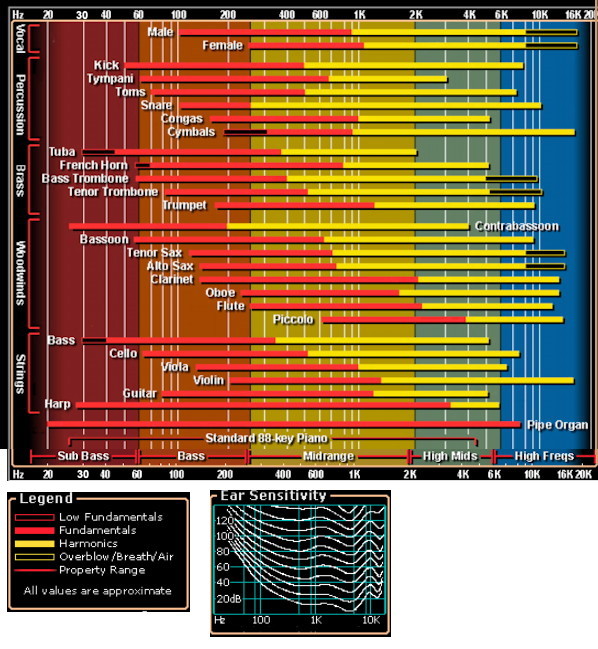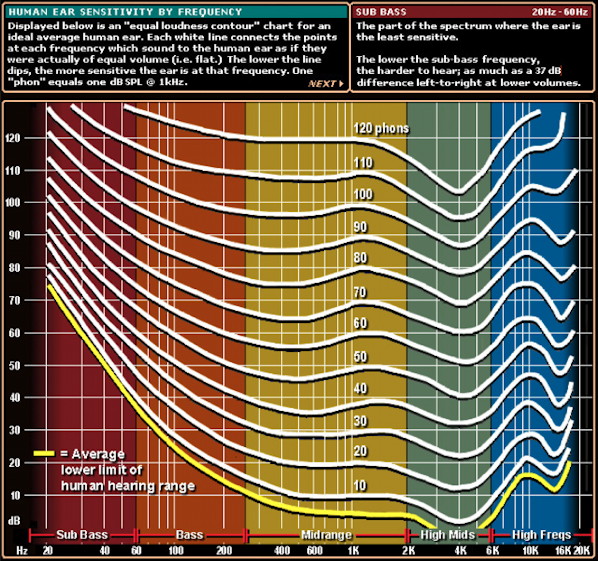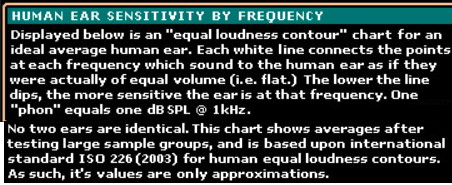 Technology
Technology
 Sound
Sound
 Sound Frequency/Pitch
Sound Frequency/Pitch
Don's Home
 Technology
Technology
 Sound
Sound
 Sound Frequency/Pitch
Sound Frequency/Pitch
| Contact |
 Under Construction. Under Construction.See also: Sound Frequency | Sound Loudness Audio - stereo - Home Theater (Surround Sound) in home and garden. Frequency Response Specs Subwoofers
Sound is a mechanical wave that results from the back and forth vibration of the particles of the medium through which the sound wave is moving.
Loudness is measured in decibels (dB). A decibel is one tenth of a bel, a seldom-used unit named in honor of Alexander Graham Bell. | ||||||||||||||||||||||||||||||||||||||||||||||||||||||||||||||||||||||||||||||||||||||||||||||||||||||||||||
|
See: Acceptable Noise - dBA - Levels The speed of a sound wave depends upon the medium the wave is moving through. Sound moves faster through dense materials such as wood or metal because the molecules are close together. Sound also moves faster through warmer materials because the molecules of a warm substance are colliding more often than the molecules of a cold substance.
FREQUENCY RANGE OF SOME SOUNDGenerally, the needed range for Rock music is about 60 Hz to 8,000 Hz, with Classical extending at both ends from 40 to 12,000 Hz | ||||||||||||||||||||||||||||||||||||||||||||||||||||||||||||||||||||||||||||||||||||||||||||||||||||||||||||
Examples of high and low frequencies:
Professional singers usually have a range of 3+ octives. Julie Andrews has a range of 4 octaves, from C3 below middle C to C7 above high C (some credit her with 5 octaves). |
Note 1: Note numbering starts at C. e.g. C4 follows B3. A piano keyboard goes A0, B0 Note 2: Concert pitch with A4 set to 440hz is modern. In other times and other places concert pitch may have been a different frequency, and usually a bit lower. The pitch of A440 has remained since 1939; pitches have risen a little, particularly in Eastern European countries, which often wish pianos to be tuned to A 444 or even a bit above. Note 3: Each octave represents a doubling of frequencies.
Frequency Chart from Independent Recording Network | Alexey NL Khlystov | 


RANGES OF HEARING
ULTRASOUNDUltrasound refers to sound waves that travel at very high frequencies. Doctors use ultrasound to look at soft tissues inside the human body without having to perform surgery. Ultrasonic waves reflect off soft tissue and the reflected waves can be converted into a picture, called a sonogram.Ultrasound can also be used to find tumors, break up kidney or gall stones, clean teeth, and treat muscle spasms and sprains. Ultrasonic vibrations are used to clean small metal items, such as jewelry, electronic components, and machine parts. Some General PrinciplesAt one time, the range of human hearing was considered to be from 50 Hz to 15 kHz (original definiton of high-fidelity [hi-fi]), and so recordings and playback equipment had to be able to reproduce that range of frequencies. As technical progress continued, the range was redefined as 20 Hz to 20 kHz.Digital sampling theory requires you sample at twice the maximum frequency you want to record, so CDs record a 16-bit (levels of audio) sample at a rate of 44kHz. See Digital Recording Basics. While the human ear can't hear pure tones above about 20kHz, the presence (or absence) of upper partial tones far above this frequency is clearly audible because these ultrasonic components affect the resultant waveform that the ear receives. Sony and Philips, the co-inventors of the compact disc, have publicly acknowledged the inadequacies of the 16-bit/44kHz digital format. They have a new product called the Super Audio Compact Disc (SACD) that uses a new digital recording process called Direct Stream Digital (DSD). The DSD process extends bandwidth and dynamic range far beyond the inadequate limits of compact disc. Sony's literature says the new product is "more like analog." Sound can be heard from further away in very dry air than in humid air. Water or humidity in the air absorbs much of the sound, thus reducing how far it will travel and still be heard. Wind can also reduce the distance. On a cold, dry winter day you should be able to hear sounds from greater distances than on a day before it will snow. The density of the air actually only affects the speed of the sound and not the distance it travels. Links: Music
| ||||||||||||||||||||||||||||||||||||||||||||||||||||||||||||||||||||||||||||||||||||||||||||||||||||||||||